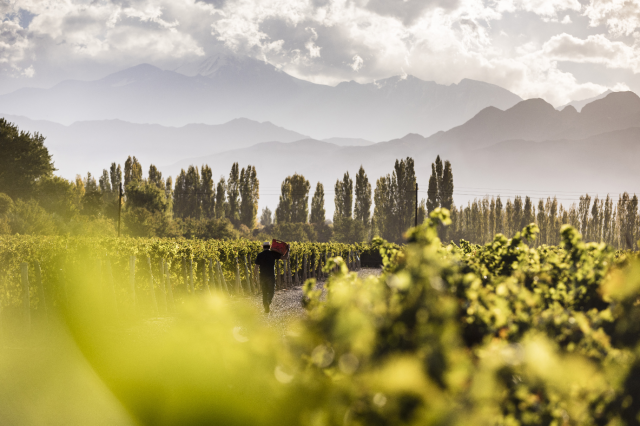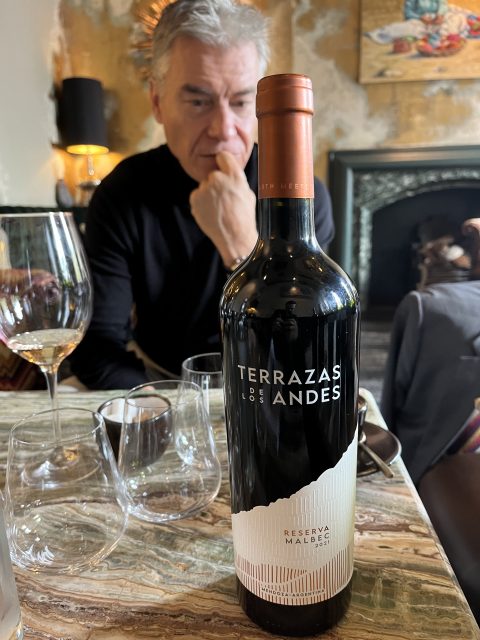Fresh thinking: high-altitude Malbec in Mendoza
Terrazas de los Andes founder and director Hervé Birnie-Scott tells db about how his pursuit of making a fresher style of Malbec in Mendoza pushes him to higher and higher altitudes.

Birnie-Scott’s journey from growing up in the Loire Valley to working over 1,000 metres above sea level in Mendoza came via other work overseas: “In ’91, being an agronomist and oenologist, and having worked for probably three years between Napa, Australia and New Zealand, I was contacted by Moët Hennessy who already owned a winery in Argentina…”
It was during his exploration of the region’s terroir over the next decades that the idea of Terrazas de los Andes began to germinate in Birnie-Scott’s mind. He noted that Argentina was “already a very big wine producer”, but that “the local market was everything”. What Mendoza presented him with was a “playground” where he could experiment and go in with “completely open eyes and absolutely no brief”.
“Great wines are grown, not made,” as Birnie-Scott said, and for him, the secret to growing those wines lies in the altitude.
“It wasn’t obvious to have French grapes in Mendoza, which has a lot of Spanish and Italian people…Malbec is a cool climate grape. There is an issue if you don’t understand that the coolness is coming with elevation and looking for freshness, then you are cultivating Malbec in the wrong place.”
“It’s the same for Cabernet Sauvignon,” Birnie-Scott continued. “It requests cool conditions – rocky soils and gravels are fine, but you need it to reach a ripeness that is not cooking the fruit.”
Terrazas de los Andes’ lofty ambitions are mirrored by the elevation of its vineyards, with El Espinillo at Gualtallary, 1,650 m.a.s.l., being its highest, a climate Birnie-Scott suggested was like “Champagne with sun”. Describing the wines from this elevation, he said: “It has this kind of cassis, just at the edge of herbaceousness, but balanced…The evolution in the bottle will bring something like graphite, even a little flinty.”
Of the Grand Malbec, Terrazas de los Andes’ icon wine, Birnie-Scott noted how each vineyard from which the grapes were sourced lent its own character to the blend. Las Compuertas (1,070 m.a.s.l.), in Lujan de Cuyo, gives it a “very classic, soft, velvety, nicely floral character”. Los Chacayes (1,200 m.a.s.l.), in Uco Valley, is “the wildest” vineyard, providing a more robust contrast. Los Castaños (1,100 m.a.s.l.), also in Uco Valley, which lends an element of the “new classic” style.
Together, in proportions that vary from year to year, the wine has “more density, more concentration” than Terrazas de los Andes’ regular Malbec, but “always small, vibrant dark fruits” with the acidity intact.
Even with the cooling effect of altitude, early picking has been key to avoiding over-ripe fruit and preserving natural acidity. The decision to do so was partly a result of the 2020 harvest being brought forward due to the impending lockdown: “This harvest made us do in one year what we might have done progressively in five. We moved from harvesting the bulk of our grapes in the first half of April to finishing on 21 March – and since then, even in a cooler year like ’21, we’ve finished the harvest in March.”
Partner Content
“Through proper viticulture you can have something balanced in terms of phenols that are ripened, despite the early harvest, and reduced irrigation fostering the early ripening of the skin, you can harvest when the aroma is at its peak.”
This more delicate, vibrant style is a stark contrast to the big, rich wines that consumers typically associate with Argentinian Malbec: “We know that people are expecting some very sweet tannins and big, round Malbec, but the trend in the world is towards elegance and drinkability.”
Climate change is presenting challenges to the quest for freshness, with higher and higher altitudes sought, reaching heights that seemed inconceivable 20 years ago: “1,650m elevation for the highest vineyard is weird!”
But increased elevation brings increased risks of its own, beyond the hail typically associated with Mendoza: “The climatic accidents related to frost are tougher. We have suffered a lot this year – yesterday and the day before we lost a lot of grapes to one of the worst frosts of the last 20 years. We will have to cope with less water and more frost. We know how to manage heatwaves, but with frost we cannot do anything.” Just after this interview, Mendoza’s government declared a state of emergency over the frosts.
While coal burners can provide enough warmth to reduce grape losses, the decision was taken to stop the “active fight” against frost due to the environmental impact of such heaters: “In one night, the emissions of CO2 was the equivalent of 10 times the emission of CO2 of cultivation per year. 10 years from one night.”
Terrazas de los Andes will be trying wind-meshing as a low-carbon alternative, but weathering extreme conditions is still an uphill struggle: “With this new climate you have to get ready to find solutions against climatic accidents. When you lose 100% of your fruit above 1,400m, it’s tough.”

Despite some of the difficulties that come with making wine at such altitudes, Birnie-Scott has no plans to descend. The new label for Terrazas de los Andes is a celebration of the mountains: “It shows our ascension journey over all these years, higher and higher, and the purity of this pristine terroir and the white glaciers that provide the water.”
Other Argentinian producers are also experimenting with altitude. To read how Bemberg is finding different expressions of Malbec at different altitudes, click here.
Related news
Castel Group leadership coup escalates
For the twelfth day of Christmas...
Zuccardi Valle de Uco: textured, unique and revolutionary wines




